Looking at Clients
Once connected, clients just
need to collect local player control information and
send it up to the server. Between the updates received from the server, the
clients
guess (using dead reckoning) how to handle all the game characters based on
their
last known state.
For example, all characters
that were walking at the last update keep walking until
the server signals them to stop. In this way, the game-play appears smooth, and
with
a good network connection, server updates are received fast enough for the game
to stay entirely in sync.
As illustrated in Figure 19.8,
whenever a client makes a change in action (such as
walking in a different direction than in the last known state), that change in
state is
immediately relayed to the server, which immediately sends that action to all
connected
clients. In that way, synchronization is much better.

Speaking of changes in player
actions, exactly what actions can a player perform?
Navigation for one. As players walk around the map, their direction of travel is
sent
up to the server. Notice that only the direction of travel is sent.
If you allow clients to specify
their coordinates when they move, you’re inviting
cheaters to mess with the values. Instead, the server will modify the
coordinates of
the player and send those coordinates back to the clients (at which time, it
doesn’t
matter whether cheaters modify the values, because the server can’t be
affected).
For specific actions, such as
walking, clients are allowed to change their own states.
As a result, players can move between server updates. For actions such as
attacking,
only the state change is sent to the server, which in turn processes the attack
and
sends out the appropriate state changes to all clients.
Players can be updated only
every 33ms. The updates are time-limited in order to
make sure the clients don’t flood the server with thousands of actions. By
keeping
actions to a minimum, the server can process things more quickly, and the
gameplay
stays smooth.
Whenever the server does send
those crucial updates to the client, the client will
immediately change the state of the characters (or characters) in question (no
need for a message queue here). This update can also include the local player,
so
as you’re moving around, some jumps in the action can occur due to the client
synchronizing
to the server.
Well, enough of the
explanations; let’s get on to making an actual network game!